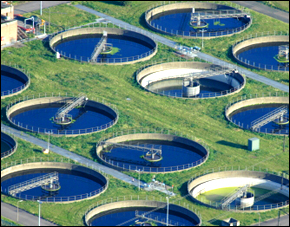UK Water Company Turns Fecal Waste into Energy, Saves Money
 Human waste is a cheap energy source for Thames Water, which is in a price dispute with the UK’s water regulator.
Human waste is a cheap energy source for Thames Water, which is in a price dispute with the UK’s water regulator.
Thames Water, the largest water provider in the United Kingdom, saved £15 million (US$25 million) last year by using human feces as a source of renewable energy, the Press Association reports.
The company uses two methods for turning the waste into heat. It burns cakes of dried sewage to generate thermal power, or it burns the methane gas produced from anaerobic digestion when microorganisms break down the sewage.
“There’s no polite way of saying this,” said Keith Colquhoun, climate change strategy manager at Thames Water, to the Press Association, “but what we produce – our poo – isn’t simply waste. It’s a great source of energy.”
“That’s good news because we treat 2.8 billion liters of sewage everyday at our 349 sewage works.”
Once the sewage has been used to generate electricity, it is given to farmers for use as manure.
In the 2008-09 fiscal year Thames Water put 100 percent of its sewage to beneficial use, sending none to the landfill, according to the Press Association.
The savings are welcome news for the company, which was recently denied the water rate increase it requested from the Office of Water Services (Ofwat) – the regulator of the UK’s privatized water sector.
Thames asked for an average annual rise in prices of 3.4 percent over the next five years, but Ofwat fixed the increase at 1.4 percent, the Financial Times reports.
The water supply sector was privatized in the UK in 1989. Ofwat is charged with setting price caps that ensure water companies make a sufficient profit and protect consumers from excessive rates.
David Owens, then CEO of Thames Water, disagreed with the new price cap, arguing that the company needed the higher prices to make improvements on leaky infrastructure and maintain its large network. Owens resigned from his position the week following Ofwat’s decision.
“We are not going to be funded to cut leakage any further, only to keep it where it is,” a spokesman for the water company said to the Times Online.
Thames Water serves 13.6 million customers in London and the Thames Valley through its water and sewerage services, according to its website.
Source: Press Association, Financial Times
Read more from Circle of Blue about how Thames Water is helping London reduce bottled water consumption.
Brett writes about agriculture, energy, infrastructure, and the politics and economics of water in the United States. He also writes the Federal Water Tap, Circle of Blue’s weekly digest of U.S. government water news. He is the winner of two Society of Environmental Journalists reporting awards, one of the top honors in American environmental journalism: first place for explanatory reporting for a series on septic system pollution in the United States(2016) and third place for beat reporting in a small market (2014). He received the Sierra Club’s Distinguished Service Award in 2018. Brett lives in Seattle, where he hikes the mountains and bakes pies. Contact Brett Walton






Leave a Reply
Want to join the discussion?Feel free to contribute!